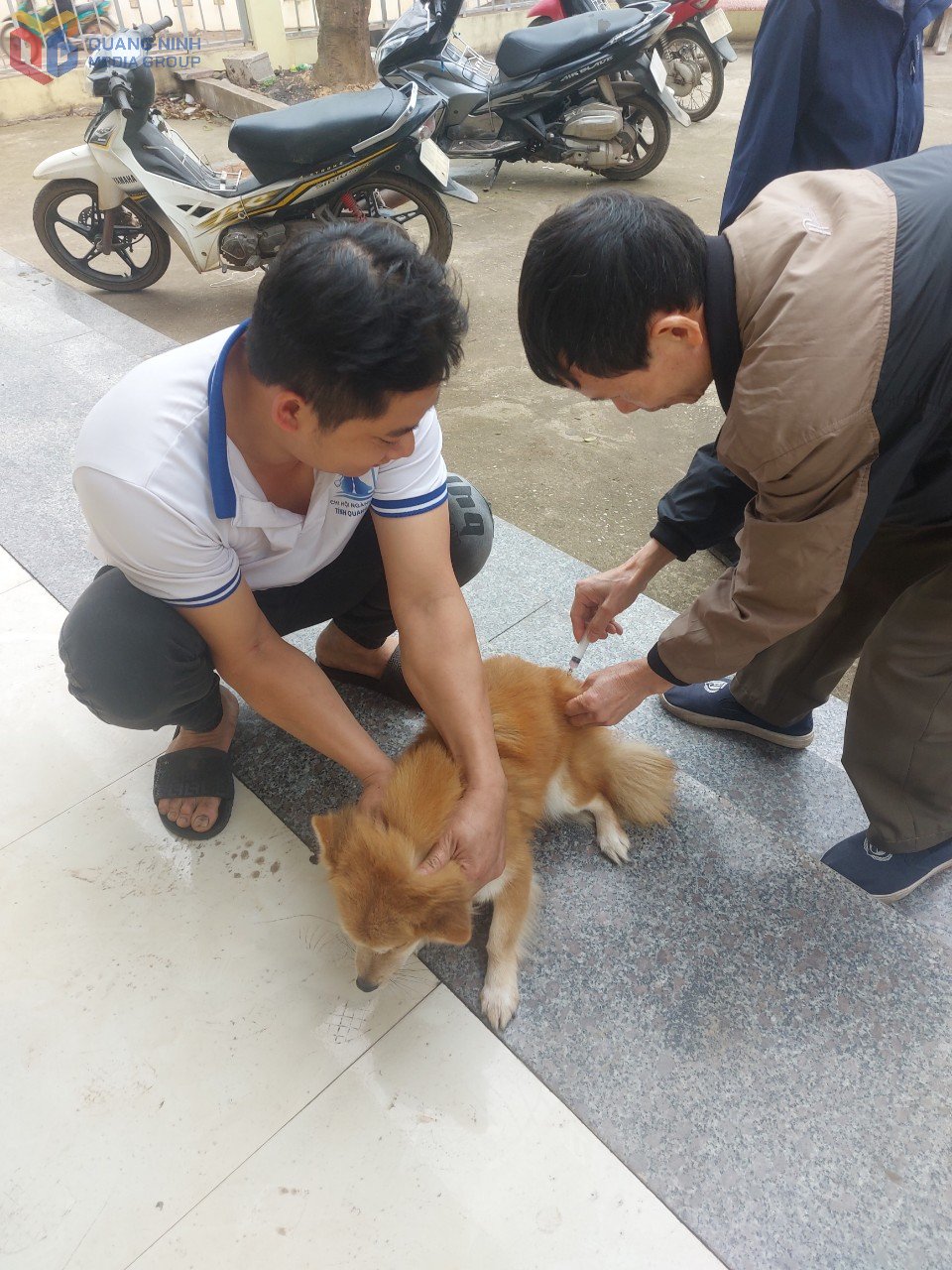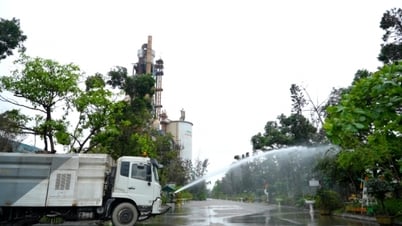According to the report of the Department of Agriculture and Environment, in 2024, the results of vaccination against new diseases will reach an average of 70% per year. Specifically: Foot and mouth disease in livestock will reach nearly 86,000 doses (62% of the annual plan); erysipelas in livestock will reach over 36,700 doses (65% of the annual plan); lumpy skin disease in cattle and buffaloes will reach nearly 34,700 doses (65% of the annual plan); blue ear disease will reach over 31,400 doses (65% of the annual plan); avian influenza will reach nearly 3.74 million doses (74% of the annual plan); rabies will reach over 136,400 doses (144% of the annual plan).
People in Quang Yen town take their pets for rabies vaccination. Photo: Bui Nien (Contributor)
In particular, Ba Che, Binh Lieu, Dam Ha organized vaccination well, with high vaccination rates for all types of mandatory vaccines assigned by the Provincial People's Committee. The remaining localities have not met the plan, typically Mong Cai City has a sharp decrease in vaccination rates compared to previous years (except for rabies vaccine), especially for vaccines on buffalo and cows, the vaccination rate is 20-30% of the annual plan. The two localities with old avian influenza outbreaks, Dong Trieu and Quang Yen, have a fairly low vaccination rate for avian influenza in 2024, not meeting the requirements for disease prevention (less than 50% of the annual plan)...
With the motto of disease prevention as the main focus and to create active immunity, on December 12, 2024, the Provincial People's Committee issued Plan No. 290/KH-UBND on disease prevention in the agricultural sector. Accordingly, localities organize mandatory vaccinations for livestock and poultry in 2 main phases of the year. Phase 1 in March and April, phase 2 in September and October. Subjects required to be vaccinated are: Buffaloes, cows, goats (vaccines against foot and mouth disease, anthrax, lumpy skin disease); pigs (vaccines against swine fever, foot and mouth disease, African swine fever); poultry (vaccines against avian influenza); dogs and cats (rabies vaccine). At the same time, localities must proactively allocate budgets to carry out disease prevention work.
Although the Provincial People's Committee has given specific instructions, by early April 2025, the entire province had only vaccinated 45% of the planned rabies vaccine, with many localities having very low vaccination rates, such as: Van Don 0%, Hai Ha 0.5%, Co To 3.9%, Binh Lieu 18%. This is causing significant potential for rabies outbreaks. Meanwhile, according to the assessment of the Ministry of Agriculture and Environment , in recent years, rabies cases have not only appeared in the hot season, but have tended to increase year-round. Statistics from the beginning of the year to March 28, 2025, the whole country had 54 outbreaks of animal rabies in 22 provinces and cities and recorded 19 deaths due to rabies in 12 provinces and cities. Particularly, the results of monitoring rabies prevention work show that Quang Ninh is a province with rabies virus circulation, concentrated in mountainous areas and some cities. In 2024, the province recorded 10 outbreaks in 6/13 localities, increasing the number of people receiving preventive treatment after exposure to rabies virus by 27%. On March 24, 2025, in Vo Ngai commune (Binh Lieu district), 3 people were bitten by dogs and had to be vaccinated with anti-rabies serum.
Not only has the rabies vaccination rate been low, but for diseases in buffalo, cow, pig and chicken herds, localities have not yet carried out vaccination of all types. The main reason is that localities have been slow in approving estimates for vaccine support funds from the budget, so the bidding packages have been implemented late (late March 2025). It is expected that in May, localities will have vaccine sources and it is likely that by mid-July 2025, the first vaccination will be completed. Thus, it does not meet the requirements set by the province in Plan 290/KH-UBND. More dangerously, March-April is the time of changing seasons, when pathogens are easy to develop, spread and cause disease, and May is the time when pigs and poultry are ready to be sold. But at this time, vaccines on livestock that have been injected since 2024 have expired.
Ms. Chu Thi Thu Thuy, Head of the Department of Animal Husbandry and Veterinary Medicine (Department of Agriculture and Environment) said: In increasingly unusual weather conditions, if the vaccination rate on livestock herds is not guaranteed to be continuous and above 70%, it will not create natural herd immunity. When herd immunity is weakened, the disease is at risk of breaking out on a large scale with many different variants. Therefore, localities must seriously carry out the work of reviewing the total herd and speeding up the vaccination progress of livestock and poultry.
It is known that on April 4, 2025, the Prime Minister signed Official Dispatch No. 31/CD-TTg on the synchronous, drastic and effective implementation of solutions to prevent and control livestock and poultry diseases. The Official Dispatch clearly stated that provinces and cities must proactively prevent diseases for livestock, especially vaccination against dangerous infectious diseases for livestock and poultry; organize and implement vaccination for livestock, ensuring that at least 80% of the total existing livestock are vaccinated. Do not let the arrangement of local organizations and apparatus affect the work of disease prevention and control.
Queen Russia
Source: https://baoquangninh.vn/nang-ty-le-tiem-vac-xin-phong-dich-benh-tren-vat-nuoi-3353134.html





![[Photo] General Secretary To Lam receives First Deputy Secretary General of the African National Congress (ANC) of South Africa](https://vphoto.vietnam.vn/thumb/1200x675/vietnam/resource/IMAGE/2025/5/20/bb2999907e1245d5b4c7310a890d8201)
























![[Photo] Vietnamese shipbuilding with the aspiration to reach out to the ocean](https://vphoto.vietnam.vn/thumb/1200x675/vietnam/resource/IMAGE/2025/5/20/24ecf0ba837b4c2a8b73853b45e40aa7)
![[Photo] Award ceremony for works on studying and following President Ho Chi Minh](https://vphoto.vietnam.vn/thumb/1200x675/vietnam/resource/IMAGE/2025/5/20/a08ce9374fa544c292cca22d4424e6c0)



























































Comment (0)